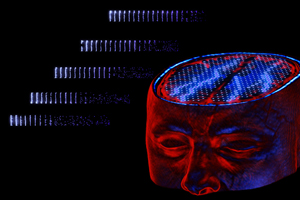On degeneracy control in overcomplete ICA

Understanding the effects of degeneracy control mechanisms when learning overcomplete representations is crucial for applying Independent Components Analysis (ICA) in machine learning and theoretical neuroscience. A number of approaches to degeneracy control have been proposed which can learn non-degenerate complete representations, however some of these methods can fall into bad local minima when extended to overcomplete ICA. Furthermore, they may have unintended side-effects on the distribution of learned basis elements, which may lead to a biased exploration of the data manifold. In this work, we identify and theoretically analyze the cause of these failures and propose a framework that can be used to evaluate arbitrary degeneracy control mechanisms. We evaluate different methods for degeneracy control in overcomplete ICA and suggest two novel approaches, one of which can learn highly orthonormal bases. Finally, we compare all methods on the task of estimating an overcomplete basis on natural images.
Sparse coding analysis of ECoG signals from sensorimotor cortex

The ability to speak is one of the most defining and complex human behaviors yet our current knowledge of the cortical processes underlying it remains very limited. High-density electrocorticography (ECoG) of speech related sensorimotor cortex (vSMC) in neurosurgical patients represents a promising opportunity to further our understanding. However, ECoG recordings are a mixture of different brain signals which makes the extraction of behaviorally relevant components challenging. In previous studies, principal components analysis (PCA) was used to analyze ECoG signals from vSMC. However, it was shown that PCA fails to identify components that are associated with individual speech articulators. In this project, we use sparse coding algorithms, such as independent components analysis (ICA) and convolutional sparse coding (CSC), and show that these techniques can separate signal components which correlate well with individual articulators and are reliable across trials. Furthermore, our results indicate that the classification of utterances from vSMC recordings improves when linear classifiers are trained using sparse codes.
Origin of evoked activity

Understanding how the spiking features of evoked activity are generated could help us elucidate how the brain processes information. Current hypotheses attribute their origin to the connectivity of the receiving network in the cortex. However, these features may be reflecting aspects of the arriving activity that are necessary to process the stimulus. We studied the transfer of spiking statistics in feedforward networks and explored which aspects of the stimulus could be used to transmit relevant dynamical features. Using recurrent EI networks, we show that a change within a biologically realistic range of the correlation structure in the input source can reproduce the dynamics observed during evoked responses. Our results suggest the consideration of a feedforward model as a possible explanation for the generation of evoked activity.
Communication through resonance

Image created by Gunnar Grah, Sebastian Spreizer and Alejandro F. Bujan
The cortex processes stimuli through a distributed network of specialized brain areas. This processing requires mechanisms that can route neuronal activity across weakly connected cortical regions. Routing models proposed thus far are either limited to propagation of spiking activity across strongly connected networks or require distinct mechanisms that create local oscillations and establish their coherence between distant cortical areas. Here, we propose a novel mechanism which explains how synchronous spiking activity propagates across weakly connected brain areas supported by oscillations. In our model, oscillatory activity unleashes network resonance that amplifies feeble synchronous signals and promotes their propagation along weak connections ("communication through resonance"). The emergence of coherent oscillations is a natural consequence of synchronous activity propagation and therefore the assumption of different mechanisms that create oscillations and provide coherence is not necessary. Moreover, the phase-locking of oscillations is a side effect of communication rather than its requirement. Finally, we show how the state of ongoing activity could affect the communication through resonance and propose that modulations of the ongoing activity state could influence information processing in distributed cortical networks.